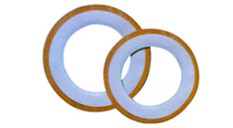Non-Metallic gaskets are sealing components made from materials that do not contain metals, such as rubber, graphite, PTFE, or compressed non-asbestos fibers. They are used to create a tight seal between two surfaces, preventing leaks of fluids or gases in various industrial applications. These gaskets are known for their flexibility, corrosion resistance, and ability to conform to irregular surfaces, making them ideal for use in piping systems, engines, and machinery where metal gaskets might fail due to galvanic corrosion or thermal expansion issues.
Our non-metallic gaskets are manufactured to meet international standards, including ASME, ASTM, and DIN. Below is a detailed table of common parameters for different types of non-metallic gaskets.
| Material Type | Temperature Range | Pressure Range (PSI) | Thickness (inches) | Applications |
|---|---|---|---|---|
| PTFE (Polytetrafluoroethylene) | -100°F to 500°F (-73°C to 260°C) | Up to 1500 | 1/16 to 1/4 | Chemical processing, pharmaceutical |
| Graphite | -400°F to 1000°F (-240°C to 538°C) | Up to 2500 | 1/32 to 1/8 | High-temperature flanges, heat exchangers |
| Rubber (EPDM, Nitrile) | -40°F to 300°F (-40°C to 149°C) | Up to 1000 | 1/32 to 1/2 | Water systems, automotive |
| Compressed Non-Asbestos Fiber (CNAF) | -100°F to 750°F (-73°C to 399°C) | Up to 1800 | 1/16 to 1/4 | General industrial, oil and gas |
Additional parameters include density, tensile strength, and compression set, which vary based on material and design. For custom requirements, we offer tailored solutions with specific certifications.
What are the advantages of using non-metallic gaskets over metallic ones?
Non-metallic gaskets offer better corrosion resistance, are more flexible, and can handle thermal cycling without losing seal integrity. They are also generally less expensive and easier to install.
How do I choose the right non-metallic gasket material for my application?
Consider factors like temperature, pressure, chemical exposure, and media type. For example, use PTFE for aggressive chemicals, graphite for high temperatures, and rubber for water or air systems.
Can non-metallic gaskets be used in high-pressure environments?
Yes, certain types like graphite-based or spiral wound non-metallic gaskets can withstand pressures up to 2500 PSI, but always check the manufacturer's specifications for your specific conditions.
Are non-metallic gaskets reusable?
Most non-metallic gaskets are not designed for reuse because they compress and deform during installation. Reusing them can lead to leaks; it's recommended to replace them during maintenance.
Do non-metallic gaskets require special installation techniques?
Installation is straightforward: ensure surfaces are clean and flat, apply even torque to bolts in a crisscross pattern, and avoid over-tightening to prevent damage. Follow industry standards like ASME PCC-1 for guidelines.
How do environmental factors affect non-metallic gasket performance?
Extreme temperatures, UV exposure, or ozone can degrade some materials. For outdoor or harsh environments, select gaskets with appropriate ratings, such as EPDM rubber for weather resistance.
What certifications do your non-metallic gaskets have?
Our products meet certifications like ISO 9001, API 6A, and FDA standards for specific applications, ensuring quality and safety in industries like oil and gas or food processing.
Can I get custom-sized non-metallic gaskets?
Yes, we provide custom cutting and fabrication services to match unique dimensions and specifications, with quick turnaround times for urgent projects.
Non-metallic gaskets are widely used in sectors such as oil and gas, chemical processing, water treatment, power generation, and automotive industries. Their versatility and reliability make them essential for preventing leaks and ensuring operational safety.





